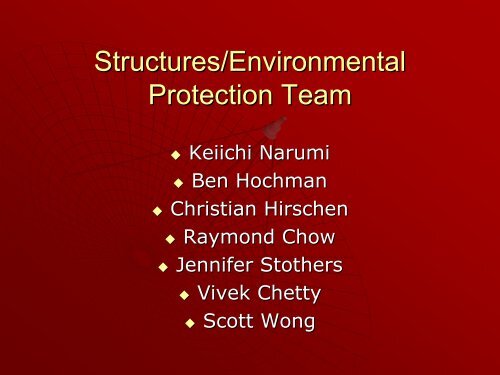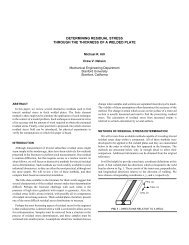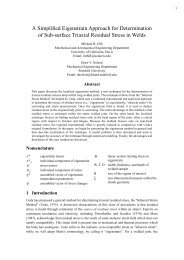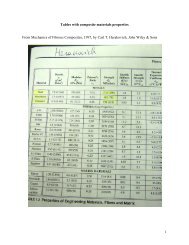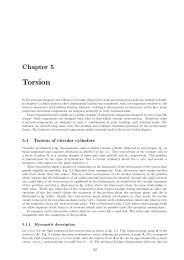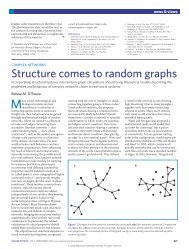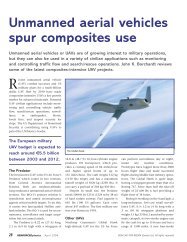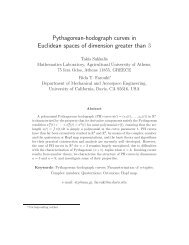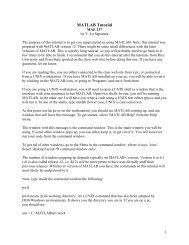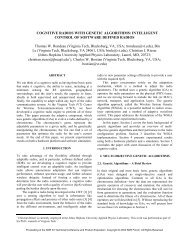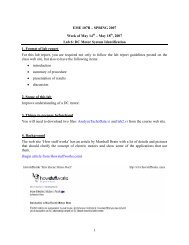Structures / Thermal Group
Structures / Thermal Group
Structures / Thermal Group
You also want an ePaper? Increase the reach of your titles
YUMPU automatically turns print PDFs into web optimized ePapers that Google loves.
<strong>Structures</strong>/Environmental<br />
Protection Team<br />
Keiichi Narumi<br />
Ben Hochman<br />
Christian Hirschen<br />
Raymond Chow<br />
Jennifer Stothers<br />
Vivek Chetty<br />
Scott Wong
Overview of Our Task<br />
Structural Expectation<br />
1. Space<br />
2. Re-entry Re entry<br />
3. Landing on Mars<br />
Past Structural Failure<br />
<strong>Thermal</strong>/Radiation Control on Board<br />
<strong>Thermal</strong>/Structural Protection Against Re- Re<br />
Entry/Environment<br />
Comparison of Each Option of Structural<br />
and Landing Materials
Environment in Space and on Mars<br />
Why do we have to take the environmental conditions into account?<br />
Constraints for thermal and radiation shielding and the requirements<br />
for the materials which have to be used (e.g. entry in atmosphere<br />
causes high temperatures)<br />
Determine the life cycle of all the equipment (e.g. radiation causes<br />
malfunction)<br />
Temperature limits for spacecraft electronics (e.g. batteries<br />
from 5 to 20 deg C)<br />
<strong>Structures</strong> and environmental Protection against <strong>Thermal</strong>/Radiation in Transit and on Ground
1. <strong>Thermal</strong> Conditions<br />
•in Space<br />
Environment in Space and on Mars<br />
– Space is more or less a vacuum except the constituents of the<br />
exosphere hydrogen and helium in very low densities<br />
– Temperature depends mainly on whether you are exposed or not to<br />
sunlight and how far you are away from the sun<br />
– The coldest temperature is 3K, this is the temperature of the cosmic<br />
microwave background radiation (CMB), so without any other heat<br />
sources, gas will come in equilibrium with the CMB<br />
– There is not one temperature for the space, but it is very<br />
variable<br />
<strong>Structures</strong> and environmental Protection against <strong>Thermal</strong>/Radiation in Transit and on Ground
Environment in Space and on Mars<br />
Earth Atmosphere<br />
http://liftoff.msfc.nasa.gov/academy/space/atmosphere.html<br />
<strong>Structures</strong> and environmental Protection against <strong>Thermal</strong>/Radiation in Transit and on Ground
1. <strong>Thermal</strong> Conditions<br />
• on Mars<br />
Environment in Space and on Mars<br />
– The six most common components of the atmosphere are :<br />
•Carbon Dioxide (CO2): 95.32%<br />
•Nitrogen (N2): 2.7%<br />
•Argon (Ar): 1.6%<br />
•Oxygen (O2): 0.13%<br />
•Water (H2O): 0.03%<br />
•Neon (Ne): 0.00025 %<br />
– Martian air contains only about 1/1,000 as much water as our air<br />
Enough to condense out and form clouds and local patches of<br />
morning fog<br />
<strong>Structures</strong> and environmental Protection against <strong>Thermal</strong>/Radiation in Transit and on Ground
1. <strong>Thermal</strong> Conditions<br />
• on Mars<br />
Environment in Space and on Mars<br />
– The average recorded temperature on Mars is -63° C (-81° F) with a<br />
maximum temperature of 20° C (68° F) and a minimum of -140° C (-220° F)<br />
– During entry into the Martian atmosphere the temperature can reach values<br />
up to 2000 deg C, even though the density is much smaller than on earth<br />
– For the different mars missions the pressure varied between 6 and 11<br />
millibars, which is around 1/1000 of the earth pressure<br />
<strong>Structures</strong> and environmental Protection against <strong>Thermal</strong>/Radiation in Transit and on Ground
Environment in Space and on Mars<br />
http://www.dfg.de/raumtransportsysteme/rueckkehr_2.html<br />
<strong>Structures</strong> and environmental Protection against <strong>Thermal</strong>/Radiation in Transit and on Ground
Environment in Space and on Mars<br />
Mars Statistics<br />
Mass (kg) 6.42E+23<br />
Mass (Earth = 1) 1.07E-01<br />
Equatorial radius (km) 3,397.20<br />
Equatorial radius (Earth = 1) 5.33E-01<br />
Mean density (gm/cm^3) 3.94<br />
Mean distance from the Sun (km) 227,940,000<br />
Mean distance from the Sun (Earth = 1) 1.5237<br />
Rotational period (hours) 24.6229<br />
Rotational period (days) 1.025957<br />
Orbital period (days) 686.98<br />
Mean orbital velocity (km/sec) 24.13<br />
Orbital eccentricity 0.0934<br />
Tilt of axis (degrees) 25.19<br />
Orbital inclination (degrees) 1.85<br />
Equatorial escape velocity (km/sec) 5.02<br />
V isual geometric albedo 0.15<br />
Magnitude (Vo) -2.01<br />
Minimum surface temperature -140°C<br />
Mean surface temperature -63°C<br />
Maximum surface temperature 20°C<br />
Atmospheric pressure (bars) 0.007<br />
www.solarviews.com/eng/mars.htm<br />
<strong>Structures</strong> and environmental Protection against <strong>Thermal</strong>/Radiation in Transit and on Ground
Environment in Space and on Mars<br />
Martian Atmosphere<br />
http://abenteuer-universum.vol4u.de/mars.html<br />
<strong>Structures</strong> and environmental Protection against <strong>Thermal</strong>/Radiation in Transit and on Ground
Environment in Space and on Mars<br />
Temperature Limits<br />
• Spacecraft electronics from around 0 to 40 deg C<br />
• Batteries from 0 to 15 deg C<br />
• Silicon Solar Cells from -100 to 100 deg C<br />
• Structure from -45 to 65 deg C<br />
• <strong>Structures</strong> supporting equipments with extremely accurate appointing<br />
requirements are limited to +/- 0.5 deg C variation<br />
<strong>Structures</strong> and environmental Protection against <strong>Thermal</strong>/Radiation in Transit and on Ground
2. Radiation<br />
Environment in Space and on Mars<br />
• Three different types of radiation<br />
– SPE: Solar Particle Elements<br />
– GCR: Galactic Cosmic Ray<br />
– Trapped Radiation<br />
<strong>Structures</strong> and environmental Protection against <strong>Thermal</strong>/Radiation in Transit and on Ground
Environment in Space and on Mars<br />
– SPE: Solar Particle Elements<br />
• Produced by the acceleration of solar plasma by strong electromotive<br />
forces and produced by acceleration across the transition shock<br />
boundary of propagating coronal mass ejecta<br />
• Occur in association with solar flare<br />
• Are rapid increases in the flux of energetic particles (~1 MeV to above<br />
1GeV), lasting from several hours to several days<br />
• Degrade solar panels, increase background noise and cause illnesses<br />
<strong>Structures</strong> and environmental Protection against <strong>Thermal</strong>/Radiation in Transit and on Ground
Environment in Space and on Mars<br />
– GCR: Galactic Cosmic Ray<br />
• GCR: galactic origin<br />
• A single particle can cause a malfunction in common electronic<br />
components → single event phenomena (SEP)<br />
• Can also generate background noise<br />
• Create spurious which masquerade as real signals<br />
• No full understanding of the physical interaction of GCR with shielding<br />
and body tissues available yet<br />
→ large impact on costs<br />
<strong>Structures</strong> and environmental Protection against <strong>Thermal</strong>/Radiation in Transit and on Ground
Environment in Space and on Mars<br />
– Trapped Radiation (Van Allen radiation belts)<br />
• In this case particles are trapped within the confines of the geomagnetic<br />
field<br />
• The trapped radiations consist mainly of protons and electrons reaching<br />
maximum intensity at an altitude 3600km followed by a minimum at<br />
7000 and a second very broad maximum at 10000km<br />
• Having energies greater than 30keV<br />
• The accumulation of these radiation events can cause permanent damage to<br />
individual detectors, electronic devices, solar arrays and sensors<br />
<strong>Structures</strong> and environmental Protection against <strong>Thermal</strong>/Radiation in Transit and on Ground
<strong>Thermal</strong> Environment<br />
Direct Sunlight<br />
Radiation<br />
Sunlight Reflected<br />
by Planets (albedo ( albedo)<br />
Infrared (IR)<br />
Radiation Emitted<br />
from a Planet’s Planet s<br />
Atmosphere or<br />
Surface<br />
Surface http://www-istp.gsfc.nasa.gov/istp/outreach/images/Solar/Events/skylab.jpg
<strong>Thermal</strong> Control<br />
Heat Emitted as IR Radiation from the<br />
Spacecraft must be Balanced with the<br />
Heat Dissipated by Internal Components<br />
and Heat Absorbed from the Environment
Custom Tailored<br />
A generic thermal control system would be<br />
heavy and expensive<br />
It is most practical to design a thermal<br />
control system for the specific needs of<br />
the mission while taking into account the<br />
worst case (hot & cold) of the<br />
environment as well as the allowable<br />
temperatures of the components and<br />
cargo.
Direct Solar Radiation<br />
Between planets,<br />
external heat<br />
comes from direct<br />
sunlight which falls<br />
off as the square of<br />
the distance to the<br />
sun.<br />
Solar constant:<br />
-Venus Venus 2700W/m 2<br />
-Saturn Saturn 15W/m 2
Heat Transfer Issues<br />
As the density of the spacecraft increases<br />
not all components can be mounted<br />
directly to a thermal control system and<br />
must be stored internally<br />
Heat transfer systems such as heat pipes<br />
must be used for internally mounted cargo
The Hot & Cold of Space<br />
Components such as batteries require<br />
small variations in temperatures (0 to<br />
15°C) 15<br />
Solar Panels can withstand much larger<br />
variations in temperature (-150 ( 150 to 110°C) 110<br />
Fuel tanks and lines must remain above<br />
freezing (15 to 40°C)<br />
40
Cryogenic Cooling<br />
IR detectors often require continuous<br />
extreme cold (125 K and below)<br />
Expendable fluids or gasses can be<br />
used as stored cryogens to absorb<br />
heat but are difficult to store due to<br />
volume constraints of the spacecraft<br />
Refrigeration systems require large<br />
amount of electrical power
Heat Balance<br />
Careful heat balance estimations must be<br />
made and although a wealth of<br />
information is available for earth orbiting<br />
spacecraft, much less is known for<br />
interplanetary missions<br />
For much longer missions, nuclear power<br />
supplies could be used and the waste heat<br />
distributed around the spacecraft
Structural Failure<br />
Example: Columbia-February Columbia February 1, 2003<br />
-One One large piece and at least two smaller pieces of<br />
insulating foam separated from the External Tank left<br />
bipod ramp area.<br />
-Later Later analysis showed that the larger piece struck<br />
Columbia on the underside of the wing, around<br />
Reinforced Carbon-Carbon Carbon Carbon panels 5 through 9.<br />
-The The foam piece was approximately 21 to 27 inches<br />
long and 12 to 18 inches wide, tumbling at a<br />
minimum of 18 times per second and 416 to 473<br />
mph at time of impact.<br />
Columbia Accident Investigation Board
Structural Design Philosophy and<br />
Criteria<br />
Launch loads are affected by<br />
acoustics<br />
acoustics<br />
engine vibrations<br />
air turbulence<br />
gusts
-Use Use a design-allowable design allowable strength for the selected<br />
material that we expect 99% of all specimens will<br />
equal or exceed.<br />
-From From available environmental data, derive a design<br />
limit load equal to the mean value plus three<br />
standard deviations.<br />
-Multiply Multiply the design limit load by a factor of safety,<br />
and then show that the stress level at this load does<br />
not exceed the corresponding allowable strength.<br />
-Test Test the structure to verify design integrity and/or<br />
workmanship, to correlate analytical models, and to<br />
protect against human errors.
Terms<br />
Load Factor<br />
Limit Load<br />
(or design limit load)<br />
Allowable Load or<br />
Stress<br />
Factor of Safety, FS<br />
Design Load<br />
Design Stress<br />
Margin of Safety,<br />
MS<br />
A multiple of weight on Earth, representing the<br />
force of inertia that resists acceleration.<br />
The maximum load expected during the mission<br />
or for a given event, at a specified or selected<br />
statistical probability (typically 99% for<br />
expendable launch vehicles and 99.87% for<br />
launches with humans aboard).<br />
The highest load or stress a structure or material<br />
can withstand without failure, based on statistical<br />
probability (usually 99%; i.e., only 1% chance the<br />
actual strength is less than the allowable).<br />
A factor applied to the limit load to obtain the<br />
design load for the purpose of decreasing the<br />
chance of failure.<br />
Limit load multiplied by the yield or ultimate<br />
factor of safety; this value must be no greater than<br />
the corresponding allowable load.<br />
Predicted stress caused by the design load; this<br />
value must not exceed the corresponding<br />
allowable stress.<br />
A measure of reserve strength:<br />
design criteria<br />
Definition<br />
Allowableload<br />
(or stress)<br />
MS =<br />
−1<br />
≥ 0<br />
Design load (or stress)<br />
to satisfy<br />
Table 11-53. Terms and Criteria Used in Strength Analysis
4. No structural test<br />
Options<br />
1. Ultimate test of dedicated qualification article (1.25 x limit)<br />
2. Proof test of all flight structure (1.1 x limit)<br />
3. Proof test of one flight unit of a fleet (1.25 x limit)<br />
Design Factors of<br />
Safety<br />
Yield<br />
1.0<br />
1.1<br />
1.25<br />
1.6<br />
Ultimate<br />
1.25<br />
1.25<br />
1.4<br />
2.0<br />
Table 11-54. Typical Test Options and Factors of Safety for Missions without Humans Aboard.
Preliminary Sizing of Structural Members<br />
Stiffness<br />
Finite element model<br />
Stiffness<br />
Strength<br />
Statically determinate structure - Free-body Free body diagrams<br />
Statically indeterminate structure – Finite element<br />
analysis<br />
Strength<br />
Weight<br />
Compare a component’s component s weight with its allocation<br />
Best design ≠ lightest design<br />
Weight
History of Failed Mars Missions<br />
Marsnik 1 & 2 – 10/10/60 and 10/14/60<br />
Its launch vehicle did not produce enough thrust to put the probe probe<br />
into the<br />
proper trajectory for Mars, and it fell back to Earth. Marsnik 2 was<br />
identical to Marsnik 1. The third stage of its rocket also failed failed<br />
during<br />
launch four days later.<br />
Sputnik 29 – 10/24/62<br />
Sputnik 29 failed to reach Earth orbit and broke apart when the Molnya<br />
rocket's fourth-stage fourth stage engine failed.<br />
Mars 1 – 11/1/62<br />
Mars 1’s 1 s signal was lost about half way through the journey on March 21, 21,<br />
1963.<br />
Sputnik 31 – 11/4/62<br />
Sputnik 31 reached Earth orbit but failed while firing the rocket rocket<br />
motor that<br />
would have put it on a trajectory for Mars.<br />
Mariner 8 – 5/8/71<br />
The main Centaur engine ignited 265 seconds after launch but the upper<br />
stage began to oscillate in pitch and tumble out of control.
Mars 2 – 5 /19/71<br />
The landers were released from the orbiter four and a half hours<br />
before the spacecraft entered Martian orbit on 11/27/1971.<br />
Lander was destroyed on impact.<br />
Mars 4-7 4 7 – 7/21/73 to 8/9/73<br />
A decision had been made two years prior to launch to replace the the<br />
gold components in the transistors with aluminum in order to save save<br />
Soviet gold resources. Mars 4 flew past Mars. Mars 5 lasted a<br />
few days. Mars 6 crashed and burned due to fast impact. Mars 7<br />
missed the planet.<br />
Phobos 1-2 1 2 – 7/7/88, 7/12/88<br />
Phobos 1: Battery died because it lost the ability to point its solar<br />
arrays toward the sun.<br />
Phobos 2: Turn antenna away from Earth to point the camera<br />
toward Phobos. Never turn back around.<br />
Mars Observer – 9/25/92<br />
Ruptured tubing in the propulsion system caused Mars Observer<br />
to spin out of control.<br />
Mars 96 – 11/16/96<br />
A failure during the second ignition of the Proton rocket’s rocket s upper<br />
stage sent the spacecraft down into the Pacific Ocean.
Nozomi – 7/4/98<br />
Might be in orbit around the Sun (could be crashing into Spirit any<br />
minute).<br />
Mars Climate Orbiter – 12/11/98<br />
“The The failed translation of English units into metric units in a<br />
segment of ground-based, ground based, navigation-related navigation related mission software.”<br />
software.<br />
Mars Polar Lander/Deep Space 2 – 1/3/99<br />
“…the “…the<br />
most probable cause of the failure (of MPL) was the<br />
generation of spurious signals when the lander legs were deployed deployed<br />
during descent. The spurious signals gave a false indication that that<br />
the spacecraft had landed, resulting in a premature shutdown of<br />
the engines and the destruction of the lander when it crashed on<br />
Mars.”<br />
Mars.
<strong>Thermal</strong> Control Components<br />
Passive Control:<br />
• Surface Finishes<br />
• Insulation<br />
• Radiators<br />
Active Control:<br />
• Heaters & Thermostats<br />
• <strong>Thermal</strong> Louvers<br />
• Heat Pipes
<strong>Thermal</strong> Control Components:<br />
Surface Finishes<br />
Select radiative properties of spacecraft surface to<br />
achieve an energy balance:<br />
Qenvironment environment + ∑Qinternal internal = Qre-radiated re radiated<br />
Two primary surface properties:<br />
- solar absorptivity,<br />
absorptivity,<br />
α<br />
- IR emissivity,<br />
emissivity,<br />
ε<br />
Surface coatings can be combined for desired average α<br />
and ε.<br />
Example: for a sphere located 1 AU from Sun (1367<br />
W/m 2 )<br />
Z93 white: white:<br />
where α/ε=0.17/0.92, =0.17/0.92, we find T=-90 T= 90°C<br />
Z306 black: black:<br />
where α/ε=0.92/0.89, =0.92/0.89, we find T=8°C T=8
<strong>Thermal</strong> Control Components: Surface Finishes:<br />
α<br />
1<br />
0.9<br />
0.8<br />
0.7<br />
0.6<br />
0.5<br />
0.4<br />
0.3<br />
0.2<br />
0.1<br />
0<br />
Solar Absorptivity (α)<br />
Of typical spacecraft surface finish categories<br />
Optical<br />
Solar<br />
Reflectors<br />
White<br />
Paints<br />
Black<br />
Paints<br />
Aluminized<br />
Kapton<br />
Surface Finishes<br />
Metallic Anodized Al
<strong>Thermal</strong> Control Components: Surface Finishes:<br />
ε<br />
1<br />
0.9<br />
0.8<br />
0.7<br />
0.6<br />
0.5<br />
0.4<br />
0.3<br />
0.2<br />
0.1<br />
0<br />
Optical<br />
Solar<br />
Reflectors<br />
IR Emissivity (ε)<br />
Of typical spacecraft surface finish categories<br />
White<br />
Paints<br />
Black<br />
Paints<br />
Aluminized<br />
Kapton<br />
Surface Finishes<br />
Metallic Anodized Al
<strong>Thermal</strong> Control Components:<br />
Multilayer Insulation (MLI)<br />
and single layer radiation shields<br />
Most common type of thermal control elements<br />
Prevents excessive heat loss or heating by environment or<br />
other spacecraft components<br />
Provides radiation protection<br />
MLI blankets<br />
• typically protect internal propellant tanks and lines, solid<br />
rocket motors, cryogenic dewars, dewars,<br />
& much more<br />
• not effective in the presence of a gas, must add foam, batt or<br />
aerogel<br />
• sensitive to mechanical compression and edge effects and can<br />
easily decrease from one to two orders of magnitude from its<br />
ideal value even when the MLI is kept under high vacuum<br />
condition<br />
Single layer radiation shields<br />
• Lesser degree of insulation<br />
• Lighter<br />
http://www.nasatech.com/Briefs/Sept03/KSC12092.HTML
<strong>Thermal</strong> Control Components: Insulation<br />
Typical MLI Composition<br />
SMAD III; Fig 11-17A, pg. 437
<strong>Thermal</strong> Control Components:<br />
Radiators<br />
Most spacecraft waste heat is rejected to space<br />
by radiators<br />
Rejects heat by IR radiation from surfaces<br />
(between 100 and 350 W)<br />
Heat rejection or heat radiating capability<br />
increases exponentially with temperature<br />
Can vary from weighing nothing to 12kg/m 2<br />
Types of finishes mostly used are quartz mirrors,<br />
silvered or aluminized teflon & white paint
<strong>Thermal</strong> Control Components:<br />
Heaters & Thermostats<br />
Heaters:<br />
Patch heater<br />
• Resistor between two flexible insulators (Kapton ( Kapton)<br />
• Redundancy required<br />
• Can be made into custom shapes<br />
Cartridge heater<br />
• Heats blocks of material or high temperature components<br />
(hydrazine-thruster (hydrazine thruster catalyst beds)<br />
• Wound resistor enclosed in metallic casing<br />
SMAD III; Fig 11-19, pg. 440
<strong>Thermal</strong> Control Components:<br />
Thermostats:<br />
Heaters & Thermostats<br />
Mechanical thermostat<br />
• Typically used for a heater that is<br />
activated only for special events or is on<br />
all the time<br />
• Fairly reliable but many used (up to<br />
several hundred)<br />
• Large dead band, >4°C >4<br />
Solid state controller (w/ temp. sensor)<br />
• Electronic device= higher reliability and<br />
life expectancy<br />
• Tight dead bands,
<strong>Thermal</strong> Control Components:<br />
Adjusts exposure of a<br />
component (radiator) to<br />
space or to other<br />
components<br />
Fully open, it allows the<br />
rejection of six times as<br />
much heat if fully closed<br />
No power required<br />
Useful when internal<br />
power dissipation varies<br />
widely<br />
Strong conductive path<br />
between actuator and<br />
radiator<br />
Louvers<br />
“Venetian Venetian-blind blind” type<br />
SMAD III; Fig 11-21, pg. 442
<strong>Thermal</strong> Control Components:<br />
Heat Pipes<br />
Wick envelope design transfers heat from one<br />
end to the other<br />
Extruded grooves enable this:<br />
• Trapezoidal<br />
Easier to make<br />
• Re-entrant<br />
Re<br />
Better capillary<br />
action<br />
Trapezoidal<br />
Easier to make<br />
entrant<br />
Better capillary<br />
SMAD III; Fig 11-22A&B, pg. 445
Application of <strong>Thermal</strong> Control Components:<br />
The NASA Rover<br />
<strong>Thermal</strong> blankets<br />
Heat pump and piping capable of<br />
transporting 150 watts of rover waste<br />
heat into space<br />
Radioisotope Heater Units (RHUs ( RHUs) )<br />
generate heat through decay of a low-<br />
grade isotope<br />
Electrical heaters<br />
Thermostatically controlled heaters<br />
Uses a Freon-like Freon like fluid for cooling
<strong>Thermal</strong> Protection during<br />
Reentry<br />
Types of <strong>Thermal</strong><br />
Insulation/Protection:<br />
1. Reinforced Carbon-Carbon<br />
2. Ceramic Tiles<br />
3. Insulation Blankets<br />
4. Ablative Materials<br />
http://tps.arc.nasa.gov
Reinforced Carbon-Carbon<br />
Carbon Carbon<br />
Used in regions where heat load ><br />
68W/cm 2 (stagnation regions) and<br />
temperature
Ceramic Tiles<br />
http://tps.arc.nasa.gov<br />
• High Temperature Reusable Surface<br />
Insulation<br />
Used in regions where heat load is < 68W/cm 2<br />
and temperature < 1500K<br />
Lightweight Ceramic Tile<br />
Cheaper than RCC<br />
Difficult to install<br />
Nomex used as stress isolation<br />
http://tps.arc.nasa.gov<br />
• Fibrous Refractory Composite Insulation<br />
Used in regions where heat load is < 68W/cm 2<br />
<br />
and temperature < 900K<br />
Easier to produce than HRSI<br />
Denser material than HRSI, comes in two grades<br />
Difficult to install
Advanced Flexible Reusable<br />
Surface Insulation Blankets<br />
Used to replace Ceramic Tiles in regions<br />
where lower heating occurs<br />
• Effective up at temperatures < 1050K<br />
• Easier to produce but has lower<br />
durability than tiles<br />
• Decrease in weight and easy to install<br />
• Also available in two grades<br />
http://tps.arc.nasa.gov
Ablative Materials<br />
Used in regions where heat load<br />
>100W/m 2<br />
Material chars and flakes or melts off<br />
• Avcoat 5026-39 5026 39<br />
• Used in Apollo Missions to shield the Command<br />
Service Module<br />
• Dense Material (ρ=1650 ( =1650 kg/m 3 )<br />
http://www.spaceaholic.com/avcoat_heatshield_full.jpg
Ablative Materials<br />
• PICA (Phenolic<br />
Impregnated Carbon<br />
Ablator)<br />
• Used on the Stardust Probe<br />
(ETA Jan 2006)<br />
• Lightweight Material (ρ=240 ( =240<br />
kg/m 3 )<br />
http://stardust.jpl.nasa.gov/photo/SC.jpg
Example of Ablation<br />
Galileo Probe entering Jupiter’s Jupiter s Atmosphere (December 1995)<br />
http://www.centennialofflight.gov/essay/Evolution_of_Technology/advanced_reentry/Tech20G3.htm
Past <strong>Structures</strong><br />
Best structure is blunt body<br />
Greater amount of friction<br />
• Decelerates the most in upper atmosphere<br />
• Easier to reduce speed to zero for landing<br />
Causes detached shock<br />
• Lower skin temperature<br />
• High temperature is further away from body
Radiation Shielding<br />
Use of Multi Layer Insulation Blankets to<br />
cut radiation exposure for payloads<br />
Effective radiation shield must have high<br />
Hydrogen atom content, helps<br />
disperse/absorb radiation<br />
• Aluminum used in the past as this was<br />
integrated into structure<br />
• Reinforced polyethylene being researched by<br />
NASA (Fiber used to produce bricks for<br />
radiation shields)
Radiation shield for computers<br />
The Radiation Shield is a software protection<br />
system for personal computers in Space running<br />
Microsoft Windows NT (made by ESA ESTEC)<br />
The radiation present in Space environment may<br />
generate parity error in parity protected memory;<br />
alternatively it can cause system faults or<br />
application errors.<br />
The Radiation Shield software is designed to<br />
handle all these errors for any running application<br />
thereby allowing it to continue or gracefully<br />
degrade, without losing significant user data.<br />
http://www.estec.esa.nl/wmwww/EME/laptops/ntradshld/index.htm
<strong>Thermal</strong> Material Cost Comparison<br />
Cost (Dollar/m^2)<br />
1.40E+05<br />
1.20E+05<br />
1.00E+05<br />
8.00E+04<br />
6.00E+04<br />
4.00E+04<br />
2.00E+04<br />
0.00E+00<br />
RCC<br />
<strong>Thermal</strong> Material Costs<br />
AFRSI<br />
HRSI<br />
AFRSI LI-900<br />
2200<br />
Material<br />
HRSI<br />
LI-2200<br />
Nomex FRSI 12<br />
RCC AFRSI AFRSI-2200 HRSI LI-900 HRSI LI-2200 Nomex FRSI-12
<strong>Thermal</strong> Material Density Comparison<br />
Density (kg/m^3)<br />
1.80E+03<br />
1.60E+03<br />
1.40E+03<br />
1.20E+03<br />
1.00E+03<br />
8.00E+02<br />
6.00E+02<br />
4.00E+02<br />
2.00E+02<br />
0.00E+00<br />
RCC<br />
AFRSI<br />
<strong>Thermal</strong> Material Density<br />
AFRSI<br />
2200<br />
HRSI<br />
LI-900<br />
HRSI<br />
LI-2200<br />
Purchase Cost<br />
Material<br />
Nomex<br />
FRSI 12<br />
Graphite<br />
Epoxy<br />
RCC AFRSI AFRSI-2200 HRSI LI-900 HRSI LI-2200 Nomex FRSI-12 Graphite Epoxy
Temperature (K)<br />
<strong>Thermal</strong> Material Max Temperature Limit Comparison<br />
2.50E+03<br />
2.00E+03<br />
1.50E+03<br />
1.00E+03<br />
5.00E+02<br />
0.00E+00<br />
RCC<br />
AFRSI<br />
<strong>Thermal</strong> Material Max Temperature<br />
AFRSI<br />
2200<br />
HRSI<br />
LI-900<br />
Material<br />
HRSI<br />
LI-2200<br />
Nomex<br />
FRSI 12<br />
RCC AFRSI AFRSI-2200 HRSI LI-900 HRSI LI-2200 Nomex FRSI-12 Graphite Epoxy<br />
Graphite<br />
Epoxy
<strong>Thermal</strong> Material Installation Time Comparison<br />
Installation Time (s/m^2)<br />
4.00E+06<br />
3.50E+06<br />
3.00E+06<br />
2.50E+06<br />
2.00E+06<br />
1.50E+06<br />
1.00E+06<br />
5.00E+05<br />
0.00E+00<br />
<strong>Thermal</strong> Material Installation Time<br />
RCC AFRSI AFRSI<br />
2200<br />
HRSI<br />
LI-900<br />
HRSI<br />
LI-2200<br />
Nomex<br />
FRSI 12<br />
RCC AFRSI AFRSI-2200 HRSI LI-900 HRSI LI-2200 Nomex FRSI-12
Density (kg/m^3)<br />
5.00E+03<br />
4.50E+03<br />
4.00E+03<br />
3.50E+03<br />
3.00E+03<br />
2.50E+03<br />
2.00E+03<br />
1.50E+03<br />
1.00E+03<br />
5.00E+02<br />
0.00E+00<br />
Structural Material Density Comparison<br />
Aluminum<br />
2024<br />
Structural Material Density<br />
Aluminum<br />
2219<br />
Material<br />
Titanium<br />
Al 2024-T8XX<br />
AL 2219-T8XX<br />
Titanium
Tensile Strength (Pa)<br />
Structural Material Tensile Strength Comparison<br />
1.20E+09<br />
1.00E+09<br />
8.00E+08<br />
6.00E+08<br />
4.00E+08<br />
2.00E+08<br />
0.00E+00<br />
Aluminum<br />
2024<br />
Structural Material Tensile Strength<br />
Aluminum<br />
2219<br />
Material<br />
Al 2024-T8XX Al 2219-T8XX Titanium Duplex Annealed<br />
Titanium
Comprehensive <strong>Thermal</strong> Material Table<br />
Units RCC HRSI LI-900 HRSI LI-2200 Normex FRSI-12 AFRSI AFRSI-2200Epoxy<br />
Purchase Cost $/m^2 1.29E+05 1.23E+04 1.25E+04 1.72E+03 1.25E+04 3.55E+03 1.25E+04<br />
Installation Time s/m^2 3.72E+05 3.53E+06 3.53E+06 2.13E+04 3.53E+06 2.36E+05 3.53E+06<br />
Inspection/Repair Time per Flight s/m^2 5.43E+03 8.14E+04 8.14E+04 3.49E+03 8.14E+04 3.72E+04 8.14E+04<br />
Replacement Fraction per Flight - 1.30E-03 2.50E-03 2.50E-03 2.80E-02 2.50E-03 1.80E-02 2.50E-03<br />
Reuse Flight Limit (# of Flights) - 3.30E-01 1.00E+02 1.00E+02 0.00E+00 1.00E+02 0.00E+00 1.00E+02<br />
Density kg/m^3 1.58E+03 1.44E+02 3.52E+02 8.65E+01 1.92E+02 9.61E+01 3.52E+02 1.58E+03<br />
<strong>Thermal</strong> Conductivity (Thru-the-thickness) W/m-K 4 4.76E-02 7.44E-02 4.06E-02 5.30E-02 3.29E-02 7.44E-02 0.6<br />
<strong>Thermal</strong> Conductivity (In plane) W/m-K 6 6.75E-02 0.1 7.96E-02 0.1 3<br />
Specific Heat J/kg-K 7.12E+02 6.28E+02 6.28E+02 1.31E+03 7.12E+02 7.41E+02 6.28E+02 8.33E+02<br />
Single Use Temperature Limit K 2.03E+03 1.76E+03 1.81E+03 6.44E+02 1.81E+03 1.09E+03 1.81E+03 5.89E+02<br />
Emissivity 0.78 8.80E-01 9.00E-01 8.00E-01 9.20E-01 8.70E-01 9.00E-01<br />
Multiple Use Temprature Limit K 1.92E+03 1.59E-03 1.64E+03 5.06E+02 1.64E+03 9.22E+02 1.64E+03<br />
Tensile Strength (Thru-the-thickness) Pa 1.65E+05 5.03E+05 1.58E+05 5.03E+05<br />
Tensile Strength (In-Plane) Pa 4.69E+05 1.25E+06 1.77E+06 1.25E+06<br />
Tensile Modulus (Thru-the-thickness) Pa 4.83E+07 1.86E+08 6.89E+07 1.86E+08<br />
Tensile Modulus (In Plane) Pa 1.72E+08 5.52E+08 3.45E+08 5.52E+08<br />
Compressive Strength (Thru-the-thickness) Pa 1.93E+05 8.96E+05 9.11E+05 8.96E+05<br />
Compressive Strength (In-Plane) Pa 4.83E+05 1.59E+06 1.83E+06 1.59E+06<br />
Coefficient of <strong>Thermal</strong> Expansion (In-Plane) 1/K 1.31E-06 4.05E-07 4.83E-07 1.30E-06 4.83E-07<br />
Dielectric Constant - 1.13E+00 1.30E+00 1.20E+00 1.30E+00<br />
Loss Tangent - 4.00E-04 1.60E-03 9.00E-04 1.60E-03
Comprehensive Structural Material Table<br />
Units Alum. 2024 Alum. 2219 Titanium<br />
Purchase Cost $/m^2<br />
Installation Time s/m^2<br />
Inspection/Repair Time per Flight s/m^2<br />
Replacement Fraction per Flight -<br />
Reuse Flight Limit (# of Flights) -<br />
Density kg/m^3 2.80E+03 2.81E+03 4.50E+03<br />
<strong>Thermal</strong> Conductivity (Thru-the-thickness) W/m-K 1.45E+02 1.19E+02 2.19E+01<br />
<strong>Thermal</strong> Conductivity (In plane) W/m-K<br />
Specific Heat J/kg-K 8.16E+02 8.62E+02 5.22E+02<br />
Single Use Temperature Limit<br />
Emissivity<br />
K 4.50E+02 4.50E+02 1.95E+03<br />
Multiple Use Temprature Limit K<br />
Tensile Strength (Thru-the-thickness) Pa 4.55E+08 4.55E+08 1.11E+09<br />
Tensile Strength (In-Plane) Pa 4.00E+08 3.50E+08<br />
Tensile Modulus (Thru-the-thickness) Pa<br />
Tensile Modulus (In Plane) Pa<br />
Compressive Strength (Thru-the-thickness) Pa<br />
Compressive Strength (In-Plane) Pa<br />
Coefficient of <strong>Thermal</strong> Expansion (In-Plane) 1/K<br />
Dielectric Constant -<br />
Loss Tangent -
Airbags<br />
http://cmex.arc.nasa.gov/CMEX/data/catalog/MarsSurveyorRover2003/ParachuteAirbagsLanding.html<br />
Vectran M Vectran HS<br />
LCP Fiber LCP Fiber<br />
Density kg/m3 1400 1400<br />
Moisture Absorption at Equilibirum Max (%) 0.1 0.1<br />
Tensile Strength Ultimate Mpa 1110 3025<br />
Elongation at Break % 2 3.5<br />
Tensile Modulus GPa 52.4 68.6<br />
Dielectric Constant 3.3 3.3<br />
Melting Point K 549 603
Parachutes<br />
http:// marsrovers.jpl.nasa.gov/mission/parachute2.html<br />
Made of polyester and nylon<br />
Bridle is made out of Kevlar<br />
In case of Exploration Rover, the parachute<br />
resisted approximately 80,100~84,600 N of<br />
force; parachutes were inflated at Mach 6 and<br />
decreased the velocity to Mach 2<br />
Size and materials depend on atmospheric<br />
density, velocity, parachute drag area and<br />
mass
Conclusion<br />
Structural design depends on weight<br />
and structural stiffness over a wide<br />
range of temperatures<br />
Learn from the past; Select best<br />
materials to accommodate needs<br />
Major factors in choosing materials<br />
Cost, Installation Time, Working<br />
Temperature, Strength
http://www.mse.berkeley.edu/classes/matsci102/F01reports/tiles.pdf<br />
http://www.mse.berkeley.edu/classes/matsci102/F01reports/tiles.pdf<br />
http://spaceflight.nasa.gov/shuttle/reference/shutref/orbiter/tps/hrcitiles.html<br />
http://spaceflight.nasa.gov/shuttle/reference/shutref/orbiter/tps/hrcitiles.html<br />
http://www-pao.ksc.nasa.gov/kscpao/nasafact/tps.htm<br />
http://www pao.ksc.nasa.gov/kscpao/nasafact/tps.htm<br />
http://er6s1.eng.ohio-state.edu/mse/mse205/lectures/chapter20/chap20.pdf<br />
http://er6s1.eng.ohio state.edu/mse/mse205/lectures/chapter20/chap20.pdf<br />
http://www.eng.iastate.edu/explorer/topics/spacecoat/HRSI.htm<br />
http://science.ksc.nasa.gov/shuttle/technology/sts-newsref/stsref<br />
http://science.ksc.nasa.gov/shuttle/technology/sts newsref/stsref-toc.html#sts_ov<br />
toc.html#sts_ov<br />
http://science.ksc.nasa.gov/shuttle/technology/sts-newsref/sts_sys.html<br />
http://science.ksc.nasa.gov/shuttle/technology/sts newsref/sts_sys.html<br />
http://www.floridatoday.com/columbia/columbiastory2A45646A.htm<br />
http://www.kc4cop.bizland.com/shuttle_tiles_1.htm<br />
http://www.tc.cornell.edu/Research/CMI/RLVsource/tps.html<br />
http://science.ksc.nasa.gov/shuttle/technology/sts-newsref/sts_coord.html#sts<br />
http://science.ksc.nasa.gov/shuttle/technology/sts newsref/sts_coord.html#sts-wing wing<br />
http://science.ksc.nasa.gov/shuttle/technology/sts-newsref/sts<br />
http://science.ksc.nasa.gov/shuttle/technology/sts newsref/sts-rcs.html#sts<br />
rcs.html#sts-rcs rcs-heaters heaters<br />
http://marsrovers.jpl.nasa.gov/mission/spacecraft_edl_aeroshell.html<br />
http://marsrovers.jpl.nasa.gov/mission/spacecraft_edl_aeroshell. html<br />
http://www.matweb.com/search/SpecificMaterial.asp?bassnum=MA2240<br />
http://www.matweb.com/search/SpecificMaterialPrint.asp?bassnum=CREADE021<br />
http://www.matweb.com/search/SpecificMaterialPrint.asp?bassnum=CREADE021<br />
http://www.matweb.com/search/SpecificMaterialPrint.asp?bassnum=PCELAN00<br />
http://www.matweb.com/search/SpecificMaterialPrint.asp?bassnum=PCELAN00<br />
http://www.matweb.com/search/SpecificMaterialPrint.asp?bassnum=PCELAN01<br />
http://www.matweb.com/search/SpecificMaterialPrint.asp?bassnum=PCELAN01<br />
http://www.matweb.com/search/SpecificMaterialPrint.asp?bassnum=PHEH32<br />
http://www.matweb.com/search/SpecificMaterialPrint.asp?bassnum=PHEH32<br />
http://tpsx.arc.nasa.gov<br />
http://www.cnn.com/interactive/space/0308/earth.mars/frameset.exclude.html<br />
http://www.cnn.com/interactive/space/0308/earth.mars/frameset.exclude.html<br />
http://www.popsci.com/popsci/aviation/article/0,12543,0459759-1,00.htmlcmex<br />
http://www.popsci.com/popsci/aviation/article/0,12543,0459759 1,00.htmlcmex-www.arc.asa.gov/CMEX/index.htmlmars.tv/missions.html<br />
www.arc.asa.gov/CMEX/index.htmlmars.tv/missions.html<br />
http://www.floridatoday.com/news/space/stories/2003b/121403marsside.htm<br />
http://www.floridatoday.com/news/space/stories/2003b/121403marsside.htm<br />
http://spaceflightnow.com/mars/mera/031231mer.html<br />
http://www.polaris.iastate.edu/EveningStar/Unit7/unit7_sub2.htm<br />
http://www.nasa.gov/columbia/caib/PDFS/VOL1/PART01.PDF<br />
http://calspace.ucsd.edu/Mars99/docs/library/mars_exploration/robotic_missions/orbiters/older_missions15.html<br />
http://calspace.ucsd.edu/Mars99/docs/library/mars_exploration/robotic_missions/orbiters/older_missions15.html<br />
http://athena.cornell.edu/mars_facts/past_missions_70s.html<br />
http://www.bbc.co.uk/science/space/exploration/missiontimeline/mars2.shtml<br />
http://www.bbc.co.uk/science/space/exploration/missiontimeline/mars2.shtml<br />
http://athena.cornell.edu/mars_facts/past_missions_80s.html<br />
http://athena.cornell.edu/mars_facts/past_missions_90s.html<br />
http://www.solarviews.com/eng/mars.htm<br />
http:// www.solarviews.com/eng/mars.htm<br />
http://www.marssociety.at/ballon5.html<br />
http://www.luke.com/marsgeo/volcanic5.html<br />
http://abenteuer-universum.vol4u.de/mars.html<br />
http://abenteuer universum.vol4u.de/mars.html<br />
Text: mars surface ionizing radiation environment: need for validation. validation.<br />
J.W. Wilson, etc<br />
http://vojager.cet.edu/iss/techcheck3/radiation.html<br />
Text: materials for shielding astronauts from the hazards of space space<br />
radiation. J.W. Wilson etc.<br />
Textbook: Space Mission Analysis and Design<br />
http://liftoff.msfc.nasa.gov/academy/space/atmosphere.html<br />
http://www.madsci.org/posts/archives/dec97/880000587.As.r.html<br />
http://www.dfg.de/raumtransportsysteme/rueckkehr_1.html<br />
http://marsrovers.jpl.nasa.gov/mission/spacecraft_edl_parachute.html<br />
http://marsrovers.jpl.nasa.gov/mission/spacecraft_edl_parachute. html<br />
http://marsrovers.jpl.nasa.gov/mission/spacecraft_edl_airbags.html<br />
http://marsrovers.jpl.nasa.gov/mission/spacecraft_edl_airbags.html<br />
Text: NASA Facts Orbiter <strong>Thermal</strong> Protection System<br />
http://www.e-composites.com/commonFiles/engineering_material_properties.asp<br />
http://www.e composites.com/commonFiles/engineering_material_properties.asp<br />
http://www.corrosion-doctors/matselect/cost.htm<br />
http://www.corrosion doctors/matselect/cost.htm<br />
http://www.physics.purdue.edu/cmsfpixs/mechanics/panel_support/materials/aluminum<br />
http://www.physics.purdue.edu/cmsfpixs/mechanics/panel_support/materials/aluminum-alloy<br />
alloy<br />
http://www.lowden-metals.co.uk/funnace/cfrc.html<br />
http://www.lowden metals.co.uk/funnace/cfrc.html<br />
http://nova.stanford.edu/projects/mod/late.html<br />
http:// nova.stanford.edu/projects/mod/late.html<br />
http://slate.msn.com/id/2093779/<br />
http://www.badastronomy.com/phpBB/viewtopic.php?t<br />
http:// www.badastronomy.com/phpBB/viewtopic.php?t=9535 =9535<br />
http://eto.msfc.nasa.gov/challenge.html#tps<br />
http://lasp.colorado.edu/snoe/lib/sc_struct.html<br />
http://www.aa.washington.edu/research/isru/ares/ares.htm<br />
http:// www.aa.washington.edu/research/isru/ares/ares.htm<br />
http://www.centennialofflight.gov<br />
http:// www.centennialofflight.gov/ /<br />
http://esapub.esrin.esa.it/bulletin/bullet87/paroli87.htm<br />
http://www.matweb.com<br />
http://www.dfg.de/raumtransportsysteme/rueckkehr_2.html<br />
http://www.nasatech.com/Briefs/Sept03/KSC12092.HTML<br />
http://www.estec.esa.nl/wmwww/EME/laptops/ntradshld/index.htm<br />
Phil Herlth, a NASA employee<br />
References
Thank You


